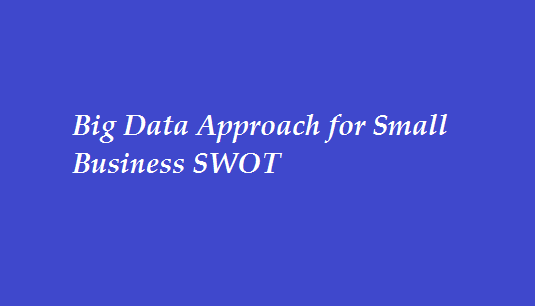
Big Data Approach for Small Business SWOT Analysis
Big Data Approach for Small Business SWOT Analysis
SWOT analysis in the business context refers to the identification of the strengths of the business, its weaknesses, the opportunities that it can grab and the threats that it needs to overcome to be able to survive in the market. SWOT analysis also empowers the business in making effective decisions for growth. SWOT analysis is thus a crucial step for small businesses towards better performance.
The strengths and weaknesses are internal to a business and to be able to grow, every business should strive to build on its strengths and eliminate its weaknesses. In absence of any concrete data, businesses are not able to objectively identify or accept their weaknesses. This becomes one of the major hindrances in the path of their growth by reducing the possibility of improvement. Moreover, businesses operate in ever-changing market environments which are a source of both opportunities and threats. While grabbing the opportunities can aid the business progress, curbing the threats is equally important for business performance.
The effectiveness of any analysis depends on the availability of accurate and relevant data. While gathering data for SWOT analysis, it is important to ensure that it is precise and not obsolete. Different systems, applications and processes generate data which is commonly termed as Big Data. There are various sources of big data including internet, social media, cloud, business processes and, transactions etc. Owing to its characteristics such as volume, variety, and velocity, big data can satisfy the SWOT analysis input needs for small businesses.
The most common sources of big data are customer profiles on websites and apps, their reviews, feedback, social media interactions, online surveys, and financial transactions. One reads various articles every day on the use of big data for business decisions. It is actually important for businesses to understand how they can best harness such data for SWOT analysis. Some ways in which the use of big data can aid small businesses’ SWOT analysis are mentioned here.
Source of identifying strengths
-
The customer comments, feedback, website views, and social sharing can help a business in identifying which features of its products are being appreciated more by the customers.
-
Demographic information about customer preferences can be used to make appropriate decisions for expanding the range of products and services in different locations.
-
Through sales data, one can reasonably conclude if the sales and marketing strategies are going in the right direction.
-
The rate of customer referrals speaks volumes about the performance of a business.
Insights into internal weaknesses
-
Bad customer reviews can help a business understand the parameters in their product or services which require re-engineering or revamp.
-
Customer comments can be used to assess whether there is a problem with the product or the poor after-sales support that is affecting it sales negatively.
-
Similarly, reviews about the market leader’s products and services can also help the business in benchmarking.
-
Big data can indicate the level of social media reach and awareness about their products and services in the market. This gives valuable information on whether the marketing and advertising strategies are effective.
Updates about opportunities in the environment
-
Data indicating an increase in demand for a particular product or service can help the business in increasing its capacity for meeting the demand.
-
Businesses grow majorly through increasing awareness of their products and services. Expos are an opportunity for the business to market itself. Big data helps in keeping updated about such expos. Such events act as a hub for businesses to get in touch with more suppliers, and clients.
-
Seminars and conferences are good platforms for businesses to increase their awareness and training programs offer opportunities to learn new technologies and trends. Big data can give updates on such upcoming events for the business to track and participate.
Proactively monitor possible threats
-
Big data can be used to gather information about the market competition due to the presence of other bigger players in the market.
-
It can also give comprehensive indications about the features and functionalities most appreciated by customers for the products of the other players in the market.
-
Sales data of the successful competitor helps the business to gauge the strategies that are making their business more popular among clients.
-
Big data can also give indications of a market trend change that can pose the threat of making one’s products or services outdated.
-
-
-
While these are just the basics, big data can give wider perspectives through efficient analytics. But, small businesses are limited by resources and it is not easy for them to go through the complete process of mining and analyzing big data all by themselves. If you are one of these small businesses, you must actively seek help from big data analytics service providers so as to make the best out of big data for your growth.